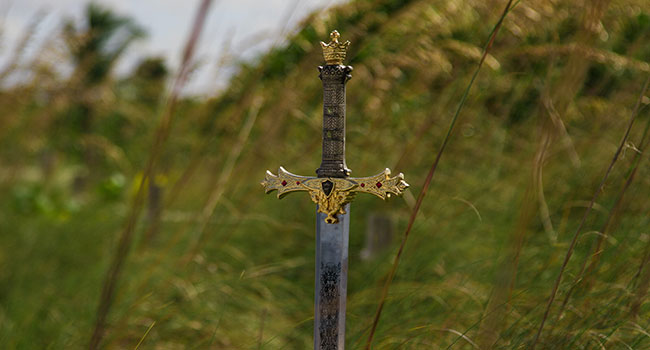 A recent news story about archaeological findings at the site of England’s Glastonbury Abbey made me think of the long-dead Hollywood actor Robert Taylor. Let me explain.
A recent news story about archaeological findings at the site of England’s Glastonbury Abbey made me think of the long-dead Hollywood actor Robert Taylor. Let me explain.
I was a month short of my ninth birthday when Taylor came to Ireland for location shooting on MGM’s production of Knights of the Round Table, and the Dublin newspapers had a field day with related stories. For me, this was a big event. I’d just revelled in Taylor’s cinematic derring-do in Ivanhoe, so all reading material I could find on Arthur and his knights was voraciously devoured.
And there’s a connection between this and the recent news item. According to a team of experts led by a Professor of Archaeology from the University of Reading, the Glastonbury story about locating the grave of King Arthur and his legendary queen, Guinevere, goes beyond mere myth. It’s apparently a total fabrication.
When the abbey burnt down in 1184, the monks had a problem: Where were they going to find the money to rebuild?
As they had little in the way of sacred relics to entice pilgrims, the monks decided to invent a compelling backstory for the abbey, one part of which related to the legend of King Arthur. In this, their timing was good as the hitherto vague legends had been given a vigorously renewed lease on life by Geoffrey of Monmouth’s The History of the Kings of Britain. In short, Arthur was medieval hot stuff, and discovering his grave on your premises was a guaranteed traffic generator.
The monks, however, weren’t alone in recognizing an opportunity. Henry II, who encouraged them to make the find, could also see the possibilities.
Legend had it that Arthur was lurking in the mists, waiting to return as the agent of Romano-Celtic liberation. But if he was revealed to be both dead and an Englishman, Henry’s Angevin dynasty could claim to be the legitimate inheritors of his legacy. And whatever else Henry may have been, he was no fool. You don’t get to create an empire running from the Scottish border to the Pyrenees by being slow on the uptake!
In the process of debunking Glastonbury’s various myths, the recent findings implicitly thrash some previous reputations, most notably that of Ralegh Radford, the archaeologist who excavated Glastonbury 50 to 60 years ago. In his day, Radford was a very big wheel in archaeological circles, considered an expert on European sites and antiquities. But the new study suggests that, at least when it came to Glastonbury and Arthur, he saw what he wanted to see.
Indeed, whether Arthur ever existed is historically debatable. Professor David Dumville hit the nail on the head when he described the best case as being of the “no smoke without fire” variety. In other words, if there are persistent long-lived legends there may well be a real basis for them, even if the reality bears little relationship to the stories.
For what it’s worth, the written origins of King Arthur’s legend can be traced to the sixth century monk Gildas, who told the story of a local king, Ambrosius Aurelianus, his struggle against the invading Saxons, and the great Romano-Celtic victory at the Battle of Badon. Later renditions introduced the character of Arthur as a hero in the battle, and the aforementioned Geoffrey of Monmouth then put it on steroids.
And the world being what it is, the story travelled. In the process, others latched on to it, taking the theme and adding their own bits. For instance, the French writer Chretien de Troyes injected the elements of chivalry, tournaments, and the search for the Holy Grail.
For us, though, the version with which we’re most familiar is Sir Thomas Malory’s 15th century rendering in Le Morte d’Arthur, wherein we get the full saga of adultery and destruction, betrayal and repentance. Certainly, this was the inspiration for MGM’s cinematic foray.
So we’re back to where we began, with Robert Taylor and his movie. Alas, having watched it on DVD a couple of years ago, I must confess that it’s something of a clunker. Taylor himself derisively referred to these knight-in-shining-armour roles as his “iron jockstrap” period, and when you watch one now, it’s easy to see why.
Life, indeed, can be remorseless. If you wait long enough, reality invariably overtakes illusion.
Troy Media columnist Pat Murphy casts a history buff’s eye at the goings-on in our world. Never cynical – well perhaps a little bit.
The views, opinions and positions expressed by columnists and contributors are the author’s alone. They do not inherently or expressly reflect the views, opinions and/or positions of our publication.
